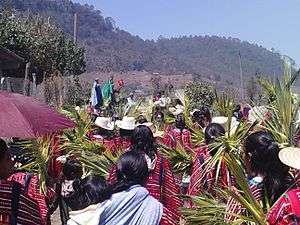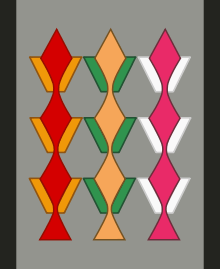Trique
triques ciudades of Oaxaca of Juárez México
 Trique people during a Palm Sunday procession | |
| Total population | |
|---|---|
| 25,883 [1] | |
| Regions with significant populations | |
| Languages | |
| Trique, Mixtec & Mexican Spanish | |
| Religion | |
| Catholic, Protestant & Native trique religion | |
| Related ethnic groups | |
| Mixtec people & Cuicatec people |

The Trique (Oaxaca pronunciation: [triki]) or Triqui (Spanish: [ˈtɾiki]) are an indigenous people of the western part of the Mexican state of Oaxaca, centered in the municipalities of Juxtlahuaca, Tlaxiaco and Putla. They number around 23,000 according to Ethnologue surveys. The Trique language is a Mixtecan language of Oto-Manguean genetic affiliation. Trique peoples are known for their distinctive woven huipiles, baskets, and morrales (handbags).[2]
Trique people live in a mountainous region, called "La Mixteca Baja", in the southwestern part of the state of Oaxaca, Mexico. The elevation within the Trique region varies between 1,500–3,000 m (4,900–9,800 ft). This high elevation permits low-lying cumulus clouds to envelop entire towns during the afternoons and evenings.
Like many other southern Mexicans, many Trique men travel to Oaxaca City, Mexico City, or the United States as day labourers or migrant workers. As the average daily salary of a rural Oaxacan is less than $5 (U.S.) and La Mixteca is the poorest region of Oaxaca, migration and remittances sent back to Oaxaca confer economic benefits to both migrant Triques and their families in Oaxaca.[3][4] Trique women are more likely to remain in the Trique region and do not travel as often as Trique men do.
Custom
One of the notable customs of Trique people is the practice of bride price. During pre-colonial and colonial times, this was a common practice amongst Native Americans in Mesoamerica, other groups like the Mixtecs of Oaxaca continue practicing a bride price based marriage. It is typical in Trique culture for a man to offer a bride's family money, food, and other products in exchange for the bride's hand in marriage. Generally, the husband and wife know each other prior to this arrangement and there is no arrangement without consent.[5] Those opposed to this custom argue that it appears to them to be like slavery or prostitution. Those opposed to intervening in this custom argue that consent is required and that this Trique custom is not conceived of as immoral.[6]
Agriculture
The Trique economic income comes through the cultivation of various crops such as corn, beans, pumpkin, chili peppers, quelite, and lima beans among others. But the most important crops are both the banana, and the coffee bean. The products are sold in tianguis (open-air markets) found in Chicahuaztla, Copala, San Martín, Itunyoso, Tlaxiaco, Putla, or Juxtlahuaca.
The Triques practice the slash and burn cultivation system. Due to the peculiar form of cultivating the earth, the work is done by various families (between 20-30 people) in order to plant Milpa (corn fields) throughout large terrains. This type of collaborate work is known as «mipa colectiva» or «milpa en compañía»
Live Stock
Another source of income for the Trique families is the raising of animals. Mainly they raise cattle, bovines, sheep, goats, pigs and horses. On a smaller scale, they also raise chicken, turkey and duck. In the lower lands, they also practice beekeeping.
Sports
The main sport practiced by the Trique people is basketball, and as such, a basketball court can be found in all their surrounding communities. Tournaments are held during local festivals where all the athletes participate. The various institutes of education also hold basketball tournaments among all the surrounding schools. Gaining in popularity, although not widely practiced among the Trique is Soccer.
See also
References
- ↑ INEGI: Lenguas indígenas y hablantes de 5 años y más al 2010
- ↑ Takahashi, Masako. Mexican Textiles: Spirit and Style. Chronicle Books. 2003.
- ↑ Murphy, Arthur D., Stepick, Alex. Social Inequality in Oaxaca: A History of Resistance and Change. Temple University Press. 1991
- ↑ Holmes, Seth M. An Ethnographic Study of the Social Context of Migrant Health in the United States. PLoS Med 3(10): e448 doi:10.1371/journal.pmed.0030448. 2006
- ↑ Foley, Jack. "Experts: Triqui dad in Greenfield followed culture's marriage tradition." The Salinas Californian. January 20, 2009. Retrieved on March 26, 2009.
- ↑ Grillo, Ioan. "Selling Brides: Native Mexican Custom or Crime?." Time. Sunday February 1, 2009. Retrieved on February 2, 2009.
Bibliography
- Fischer Lewin, Pedro; Sandoval Cruz, Fausto (2007). Triquis (in Spanish). México: CDI.